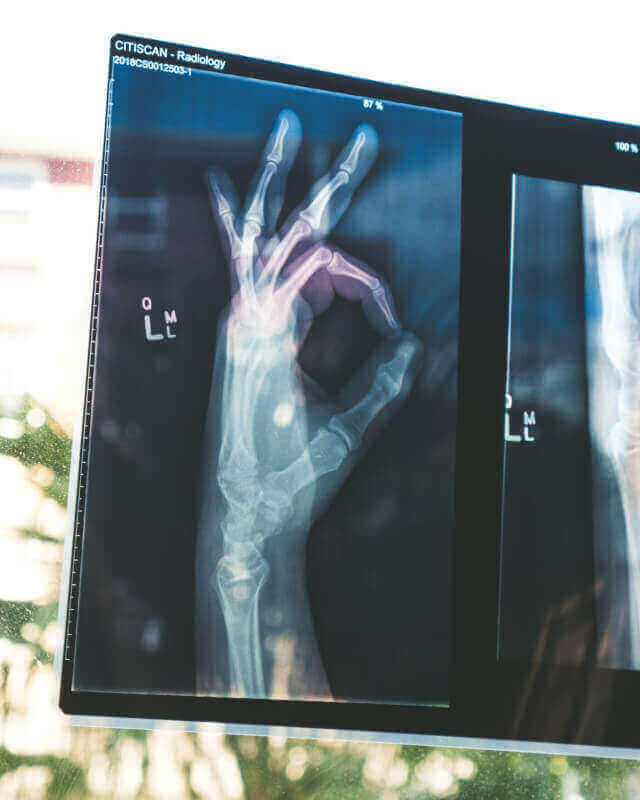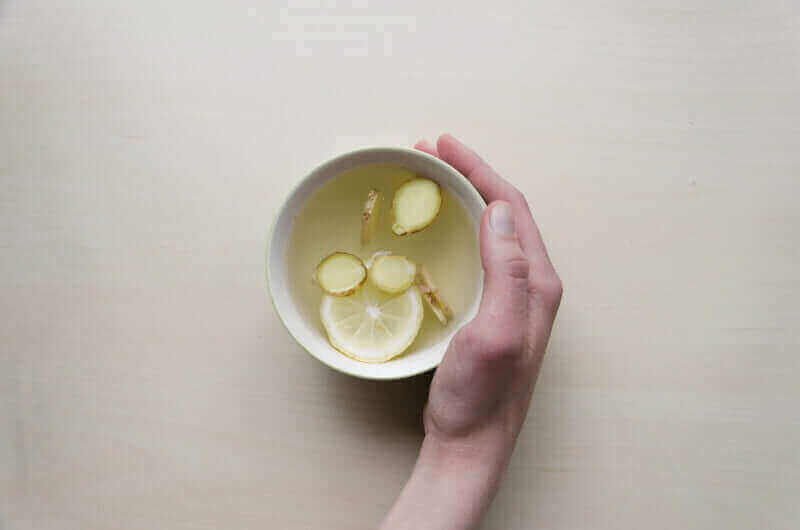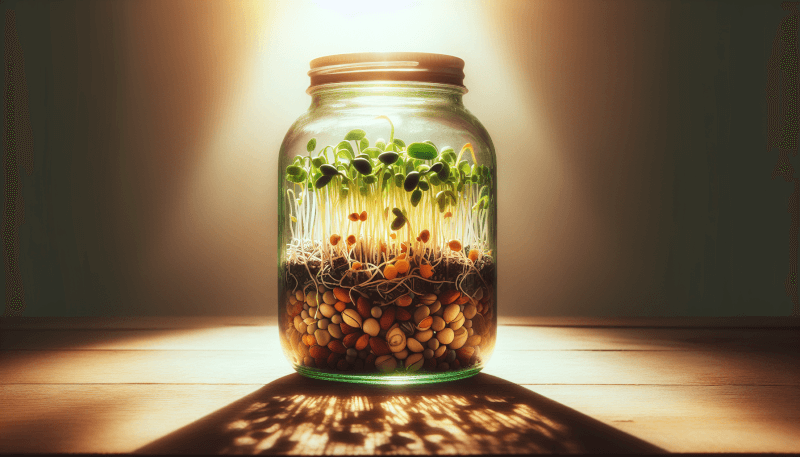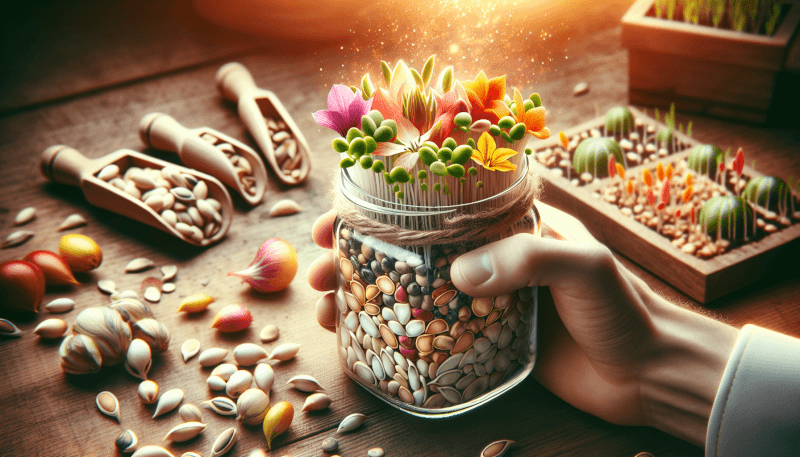👋 Click the mic button to talk to Alfred, the Todd's Seeds Gardening/Sprouting Expert – Feel free to ask him anything!
Ask Virtual Todd Anything - Click the Mic
Imagine watching your own garden bloom right before your eyes, without the need for a yard or excessive space. Introducing the Sprouting Seeds Jar, the compact solution for every aspiring gardener. Just by adding water and placing it in a sunny spot, you can transform your kitchen into a vibrant haven of fresh herbs and nutritious sprouts. This innovative jar allows you to effortlessly grow a variety of seeds, from alfalfa to broccoli, in a matter of days. Get ready to experience the joy of homegrown goodness, straight from your countertop. The Sprouting Seeds Jar brings nature’s bounty to your fingertips, making every meal a flavorful and nourishing delight.

Benefits of Sprouting Seeds
Increased Nutritional Value
Sprouting seeds is a simple and affordable way to boost the nutritional content of your meals. When seeds are sprouted, their nutrient profiles undergo a significant transformation. The sprouting process activates enzymes, which unlock the seed’s stored nutrients and make them more readily available for absorption by your body. Sprouts are known to be particularly rich in vitamins, minerals, antioxidants, and essential amino acids. Incorporating sprouts into your diet can provide a concentrated source of nutrients that may support overall health and well-being.
Improved Digestibility
Not only do sprouting seeds enhance the nutritional value, but they also improve the digestibility of the seeds themselves. During the sprouting process, complex carbohydrates and proteins present in the seeds are broken down, making them easier for your body to digest. This can be especially beneficial for those who struggle with digestive issues or have difficulty digesting certain foods. By sprouting seeds before consuming them, you can help optimize nutrient absorption and minimize digestive discomfort.
Enhanced Flavor and Texture
Sprouting seeds can also contribute to a delightful culinary experience. Many sprouts have a crisp and crunchy texture, adding a refreshing element to your dishes. Additionally, sprouts often have a slightly sweeter and milder flavor compared to their unsprouted counterparts. This can make them a versatile ingredient that can be incorporated into a variety of recipes, adding a fresh and vibrant twist to your favorite meals. Whether you enjoy them raw, lightly sautéed, or blended into a smoothie, sprouts can elevate the taste and texture of your culinary creations.
Choosing the Right Seeds
Considerations for Sprouting Seeds
When it comes to choosing seeds for sprouting, it is essential to consider a few key factors. First and foremost, ensure that the seeds you select are specifically labeled for sprouting purposes. Not all seeds are suitable for sprouting, as some may be treated with chemicals or additives that are not safe for consumption in their sprouted form. It is also important to opt for organic seeds whenever possible to minimize exposure to pesticides and other harmful substances.
Popular Sprouting Seed Varieties
There is a wide variety of seeds that can be sprouted, each with its unique taste, texture, and nutritional profile. Some of the most popular and commonly sprouted seeds include alfalfa seeds, broccoli seeds, mung beans, lentils, radish seeds, and sunflower seeds. Alfalfa sprouts are known for their mild and slightly nutty flavor, while broccoli sprouts have a more robust and peppery taste. Mung bean sprouts are often used in Asian cuisines and lend a crunchy texture to stir-fries and salads. Experimenting with different seed varieties will allow you to discover your personal favorites and tailor your sprouting endeavors to your taste preferences.
Getting Started with Sprouting Seeds
Selecting a Sprouting Jar
To begin your sprouting journey, you will need a suitable sprouting jar. A sprouting jar is specifically designed to facilitate the sprouting process by providing optimal drainage and ventilation. Look for a jar with a mesh or perforated lid that allows water to drain easily while preventing the seeds from escaping. Alternatively, you can also use a wide-mouthed mason jar and attach a piece of cheesecloth or fine mesh over the opening using a rubber band.
Prepping the Seeds
Before you start sprouting, it is crucial to properly prepare your seeds. Begin by rinsing the seeds thoroughly under cold running water to remove any debris or impurities. Then, soak the seeds in a bowl of water for the recommended amount of time specified on the seed packaging. Soaking softens the seed coats and kickstarts the germination process. After soaking, drain the seeds and transfer them to your sprouting jar.
Soaking and Rinsing Method
Once the seeds are in the sprouting jar, cover them with clean water and let them soak for the specified period mentioned for the seed variety you are sprouting. After soaking, drain the water through the mesh lid or cheesecloth, ensuring that all excess water is removed. Rinse the seeds with fresh water twice a day, gently swirling the jar to ensure that all the seeds are thoroughly rinsed. After each rinse, drain off the water completely to prevent mold or bacterial growth. Repeat the rinsing process for several days until your sprouts are ready for harvest.
Tips for Successful Sprouting
Proper Ventilation and Drainage
Ventilation is an essential aspect of successful sprouting. To ensure proper airflow, make sure to rinse and drain your sprouting seeds thoroughly after each rinse. Stagnant water can lead to mold or bacterial growth, which can spoil your sprouts. Additionally, ensure that your sprouting jar has adequate drainage to prevent water from accumulating at the bottom. If using a jar without a mesh lid, invert the jar at an angle to allow excess water to drain out.
Optimal Temperature and Lighting
While sprouting seeds, it is important to provide them with the right environmental conditions for optimal growth. Most sprouts thrive in temperatures between 65°F and 75°F (18°C-24°C). Avoid exposing your sprouts to direct sunlight, as this can cause them to dry out or overheat. Instead, place them in an area with indirect sunlight or use ambient room lighting. Keeping your sprouts at the right temperature and lighting conditions will help ensure healthy and vigorous growth.
Managing Moisture Levels
Proper moisture levels are crucial for sprouting success. While it is important to rinse your sprouting seeds regularly to prevent them from drying out, it is equally important not to overwater them. Excess moisture can lead to mold or bacterial growth, resulting in spoiled sprouts. Pay close attention to the drainage of your sprouting jar and make sure to shake off any excess water after rinsing. By striking the right balance, you can create an optimal environment for your sprouts to thrive.

Common Issues and Troubleshooting
Mold Growth
Mold growth is a common issue encountered while sprouting seeds. To prevent mold, make sure to adequately rinse and drain your sprouts after each rinse. Ensure proper ventilation to prevent moisture buildup, and avoid overcrowding your sprouting jar. If mold does appear, remove the affected sprouts immediately to prevent it from spreading. Additionally, consider using a diluted hydrogen peroxide solution or grapefruit seed extract to inhibit mold growth when rinsing your seeds.
Seed Spoilage
In some cases, seeds may spoil and fail to sprout. This can happen if the seeds are old or have been improperly stored. To prevent seed spoilage, always purchase fresh and high-quality seeds from reputable sources. Store your seeds in a cool and dry place, away from direct sunlight or moisture. If you encounter seed spoilage, discard the affected seeds and start with a fresh batch.
Stunted or Slow Growth
If your sprouts appear stunted or are growing at a slow rate, several factors may be contributing to this issue. Inconsistent rinsing, insufficient water, incorrect temperature, or lack of proper airflow can all hinder sprout growth. Review your sprouting routine and ensure that you are following the recommended methods and conditions for your chosen seed variety. Make adjustments accordingly and give your sprouts some time to recover and develop.
Harvesting and Storing Sprouts
Determining the Right Time to Harvest
The ideal time to harvest your sprouts depends on personal preference and the specific seed variety you are sprouting. As a general rule, sprouts are ready to be harvested once they have reached their desired length. This is typically when the first tiny leaves, known as cotyledons, have appeared. Taste a few sprouts to determine their flavor and texture. Once the sprouts have reached the desired consistency, it’s time to move on to the next step.
Cleaning and Drying the Sprouts
After harvest, gently remove the sprouts from the sprouting jar, being careful not to damage them. Rinse the sprouts under cold running water to remove any seed coats or residue. Use your hands or a clean cloth to pat the sprouts dry, or alternatively, use a salad spinner for more efficient drying. Ensuring that your sprouts are clean and dry will help extend their shelf life and prevent spoilage.
Storage and Shelf-Life
To prolong the freshness of your sprouts, it is important to store them properly. Place the cleaned and dried sprouts in an airtight container or a resealable bag lined with a paper towel to absorb any excess moisture. Store the sprouts in the refrigerator, where they can stay fresh for up to a week. However, it is best to consume sprouts within a few days to maximize their nutritional value and flavor.

Ways to Incorporate Sprouts into Your Diet
Adding Sprouts to Salads and Sandwiches
One of the easiest and most common ways to enjoy sprouts is by adding them to salads and sandwiches. Their crunchy texture and fresh taste make them a fantastic addition to any salad, providing a burst of flavor and nutrition. Simply toss a handful of sprouts into your favorite salad mix, or layer them on top of sandwiches for an extra crunch. You can also experiment with different sprout varieties to add a unique twist to your culinary creations.
Blending into Smoothies
Sprouts can also be a surprising and nutritious addition to your morning smoothies. Their mild flavors blend well with fruits and vegetables, adding an extra nutritional boost to your morning routine. Start by adding a small handful of sprouts to your favorite smoothie recipe and gradually increase the quantity based on your taste preferences. Blend until smooth, and enjoy the added nutrients and texture that sprouts bring to your smoothie experience.
Cooking and Stir-Frying Sprouts
If you prefer cooked dishes, sprouts can be a versatile ingredient in your cooking repertoire. They can be lightly sautéed or stir-fried, contributing a delightful crunch and texture to your dishes. Consider adding sprouts to stir-fries, omelets, or even soups. The brief cooking time helps retain their nutrient content and enhances the overall flavor of the dish. Experiment with different cooking techniques and seasonings to discover creative ways to incorporate sprouts into your favorite recipes.
Exploring Creative Sprouting Techniques
Creating Sprouting Mixes
While sprouting seeds individually offers its benefits, combining different seed varieties into sprouting mixes can yield unique and flavorful results. Experiment with creating your sprouting mixes by combining seeds with complementary flavors and textures. Some popular sprouting mix ideas include blends of lentils, mung beans, and chickpeas or combining radish and broccoli seeds for a spicy and nutritious blend. Creating sprouting mixes allows you to customize your sprouts and add variety to your meals.
Growing Microgreens
Microgreens are essentially the young seedlings of plants like broccoli, kale, and radishes. Unlike sprouts, microgreens are grown in soil or another growing medium, allowing them to develop their first set of true leaves before harvesting. Microgreens are known for their vibrant colors, concentrated flavors, and high nutritional value. Growing microgreens is a step beyond sprouting seeds and requires a bit more equipment and care, but the rewards are well worth the effort.
Sprouting in Different Containers
While sprouting jars are the most common vessel for sprouting seeds, you can also explore other creative options. Consider using shallow trays, colanders, or even recycled plastic containers with drainage holes for sprouting. Just ensure that whatever container you choose allows for proper drainage and ventilation. Exploring different sprouting containers can expand your sprouting possibilities and add a touch of uniqueness to your sprouting endeavors.

Health and Safety Considerations
Hygiene Practices
Maintaining proper hygiene practices is crucial when sprouting seeds to prevent contamination and foodborne illnesses. Always make sure to wash your hands thoroughly before handling seeds or sprouts. Cleanse your sprouting jar or container with hot soapy water before each use, and rinse it well to remove any soap residue. Regularly sanitize your sprouting equipment to minimize the risk of bacterial growth. Practicing good hygiene ensures that the sprouts you grow are safe for consumption.
Quality Sources of Seeds
To ensure the safety and quality of your sprouts, it is important to source your seeds from reputable suppliers. Look for organic and non-GMO seeds whenever possible, as they undergo fewer chemical treatments and are less likely to be contaminated. Choose trusted seed companies that specialize in sprouting seeds, as they often have rigorous quality control measures in place. By selecting high-quality seeds, you can enjoy sprouts that are not only delicious but also safe to consume.
Potential Risks and Allergies
While sprouting seeds can offer numerous health benefits, it is essential to be aware of potential risks and allergies. Some individuals may be sensitive or allergic to certain sprout varieties, particularly legumes like lentils or mung beans. If you have a known allergy or are unsure about your sensitivity, consult with a healthcare professional before incorporating sprouts into your diet. Additionally, pregnant women, young children, and individuals with compromised immune systems are advised to exercise caution when consuming raw sprouts due to the higher risk of bacterial contamination.
Conclusion
Sprouting seeds is a fantastic way to enhance the nutritional value, digestibility, and flavor of your meals. By carefully selecting high-quality seeds, ensuring proper ventilation and drainage, and managing moisture levels, you can successfully grow your own sprouts at home. From incorporating sprouts into salads and sandwiches to blending them into smoothies or cooking them in your favorite dishes, the possibilities for incorporating sprouts into your diet are endless. Embrace the journey of sprouting and explore creative techniques to add a healthy and flavorful twist to your culinary adventures. Remember to prioritize hygiene and source your seeds from reputable suppliers to ensure the safety and quality of your sprouts. So why wait? Start sprouting today and reap the bountiful benefits that sprouts have to offer!
